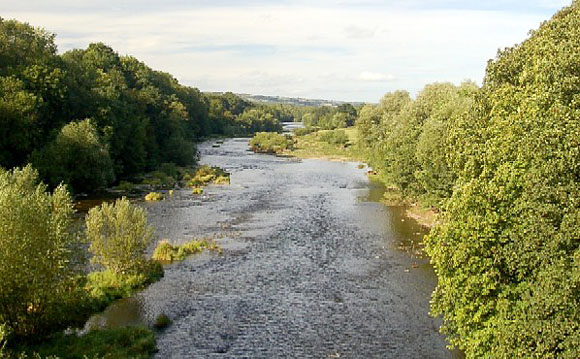The River Wye (Welsh: Afon Gŵy) is the fifth-longest river in the UK and forms part of the border between England and Wales. It is important for nature conservation and recreation.
The source of the Wye is in the Welsh mountains at Plynlimon. It flows through or past several towns and villages including Rhayader, Builth Wells, Hay-on-Wye, Hereford, Ross-on-Wye, Symonds Yat, Monmouth and Tintern, meeting the Severn estuary just below Chepstow.
The Wye itself is a Site of Special Scientific Interest and one of the most important rivers in the UK for nature conservation. Much of the lower valley is an Area of Outstanding Natural Beauty. The Wye is largely unpolluted and is therefore considered one of the best rivers for salmon fishing in the United Kingdom, outside of Scotland.
It is also a popular river with canoeists due to the relatively slow flowing water, making it good for beginners. The rapids at Symonds Yat are more challenging. Walkers can enjoy the Wye Valley Walk which follows the route of the River Wye from Hay-on-Wye to Chepstow along a series of well maintained way-marked paths.
The lower 16 miles of the river from Redbrook to Chepstow form the border between England and Wales. A viewpoint near The Biblins on the Wye is known as 'Three counties view', the meeting place of the counties of Herefordshire, Gloucestershire and Monmouthshire.
Tributaries
The Wye's tributaries include the rivers Lugg, Irfon, Monnow, Trothy, Ithon Llynfi, Letton Lake, Tarennig (the Wye's first tributary) and Bidno.
History
The river Wye has been navigable up to Monmouth at least since the early 14th century. It was improved from there to a short distance below Hereford by Sir William Sandys in the early 1660s with locks to enable vessels to pass weirs. According to Herefordshire Council Archaeology, these were flash locks. The work proved to be insufficiently substantial and in 1696 a further Act of Parliament authorised the County of Hereford to buy up and demolish the mills on the Wye and Lugg. All locks and weirs were removed, except that at New Weir Forge below Goodrich, which survived until about 1815. This was paid for by a tax on the County. Weirs removed all along the Wye in Herefordshire, making the river passable to the western boundary, and beyond it at least to Hay-on-Wye. A horse towing path was added in 1808, but only up to Hereford; previously, as on the River Severn, barges were man-hauled. Money was spent several times improving the river Lugg from Leominster to its confluence with the Wye at Mordiford, but its navigation is likely to have been difficult. The Wye remained commercially navigable until the 1850s, when commercial traffic moved to railways. It is still used by pleasure craft.
Cultural References
The Romantic poet William Wordsworth includes an apostrophe to the Wye in his famous poem "Lines Written a Few Miles Above Tintern Abbey" published 1798 in Lyrical Ballads
O sylvan Wye! thou wanderer thro' the woods,
How often has my spirit turned to thee! |

